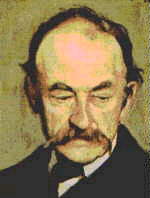|
|
|
|
| Image,
Imagery & Imagism
Image means "a concrete picture" (Harper Handbook 235). In daily language image is usually a composite of visual details, but literary images can be those of sights, sounds, tastes, touch and smells. When your composition teacher asks you to give concrete, sensory details in your narrative, you are asked to recall/re-create images of your experience so that your readers can experience and feel them, too. If you give your images figurative meanings or other meanings beyond the literal level, you are creating figurative images (metaphors or similes) or symbols. In other words,
Imagism is a movement -- led by
some American poets (e.g. E. Pound, W. C. William, etc.) in early twentieth
century -- against "Romantic idealism and Victorian moralism" (Harper Handbook
238)
|
| Symbol
In its broadest sense a symbol is any object, action or sign that "signifies more than itself" (Heath Guide to Literature 545). For instance, the cross, the number of candles on a birthday cake, the signs on the restroom, the red-yellow-green traffic light, our clothing, . . . , all of these are symbolic or have symbolic values. Human communication largely depends on these various kinds of symbolic language. Symbolism is "a hightened
use of symbol, presenting the word first for its ordinary signification
(as when the word rose stands for the flower rose) and then for
some idea lying behind the ordinary signification (as when the word
rose stands for the flower rose, which stands for beauty).
|
L Hughes "Harlem" (1951
502)
|
W. Stevens "Disillusionment of
Ten o'clock"
|
 T.
Hardy "Neutral Tones" (E-Text) T.
Hardy "Neutral Tones" (E-Text)
|
| Ezra Pound "In a Station of the Metro"
(1916 p. 677)
His
Photo,
|
Robert Frost "Mending Wall" (1914
p. 748)
|
| General Questions:
All the five poets here are Modern poets (Hardy being an early Modernist). Although definitions of Modern period (or Modernism) is not our focus in class, please remember that it is a period when people lost their faith in traditional values (such as God, Reason or progress) and then the artists sought to find values in Art or artistic innovation. Also, try to compare how some of the poems deal with 1. human relations ("Neutral Tones" and "Mending Walls"); 2. modern technology ("In the Station of the Metro"); 3. society/social problems ("Harlem" and "Disillusionment of Ten O'Clock"). |